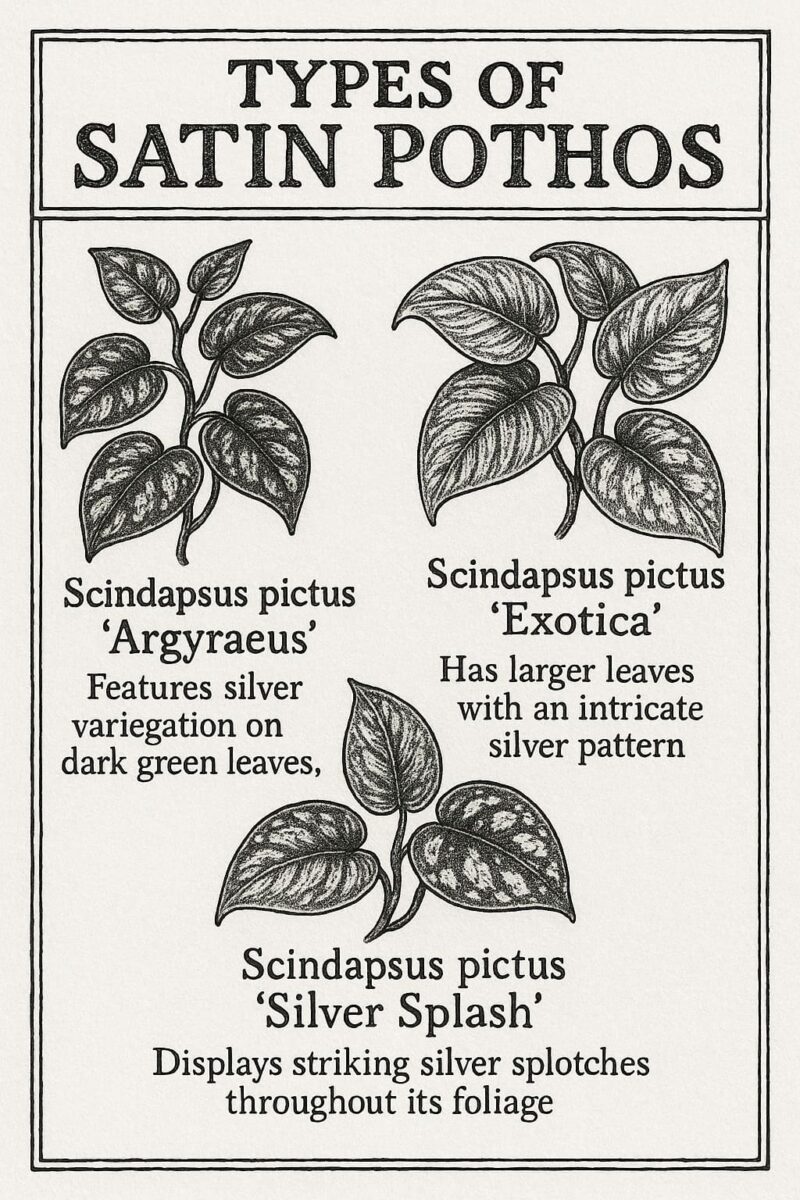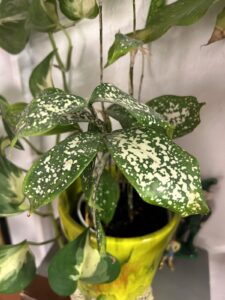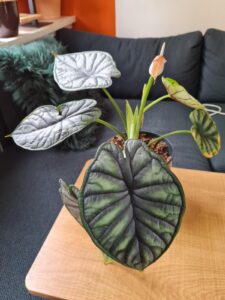
Satin Pothos (Scindapsus pictus) is a striking and resilient houseplant native to the tropical regions of Southeast Asia. Renowned for its beautiful, silvery-green foliage, this perennial vine is perfect for indoor gardening enthusiasts looking to add a touch of elegance to their space. Satin Pothos can be grown in hanging baskets or trained to climb a trellis, making it a versatile choice for various indoor settings.
Best planted in spring, this plant thrives in bright, indirect light and is known for its ability to purify the air, making it a popular choice for homes and offices alike.
| Common Name | Satin Pothos, Silk Pothos, Silver Vine |
|---|---|
| Botanical Name | Scindapsus pictus |
| Family | Araceae |
| Plant Type | Perennial |
| Mature Size | 2-4 ft. long |
| Sun Exposure | Indirect sunlight |
| Soil Type | Well-draining potting mix |
| Soil pH | Acidic to neutral (6.0 – 7.0) |
| Bloom Time | Rarely flowers indoors |
| Flower Color | White |
| Hardiness Zones | 10-12 (USDA) |
| Native Area | Southeast Asia |
| Toxicity | Mildly toxic to pets and humans |
Did you know? This plant is neither a true pothos nor a philodendron but belongs to yet another genus (Scindapsus pictus).
RELATED: Pothos vs. Philodendron: What’s the Difference?
In this article
Satin Pothos Care
Satin Pothos ✨
byu/boomahha098 inIndoorGarden
Caring for Satin Pothos is straightforward, making it an excellent choice for both novice and experienced gardeners. With the right attention, this plant can flourish and enhance your indoor environment.
Light
Satin Pothos prefers bright, indirect light but can tolerate low-light conditions. Direct sunlight may scorch its leaves, so it’s best to place it near a window with filtered light.
Water
Allow the top inch of the soil to dry out before watering, as Satin Pothos prefers to be on the drier side. In general, watering every 1-2 weeks is sufficient, but frequency may vary depending on humidity levels and pot size.
Soil
A well-draining potting mix is essential for Satin Pothos. A blend of potting soil with perlite or orchid bark will provide the aeration and drainage this plant needs to thrive.
Temperature and Humidity
Satin Pothos enjoys temperatures ranging from 65°F to 85°F (18°C to 29°C). It can tolerate lower humidity levels, but providing a moderate humidity environment will help promote healthier growth.
Fertilizer
During the growing season (spring and summer), feed your Satin Pothos with a balanced liquid fertilizer every 4-6 weeks. Reduce feeding during the fall and winter months when growth slows down.
Types of Satin Pothos

While Scindapsus pictus is the primary species, there are several popular varieties:
- Scindapsus pictus ‘Argyraeus’: Features silver variegation on dark green leaves.
- Scindapsus pictus ‘Exotica’: Has larger leaves with an intricate silver pattern.
- Scindapsus pictus ‘Silver Splash’: Displays striking silver splotches throughout its foliage.
Pruning
Prune Satin Pothos as needed to maintain its shape and remove any yellow or damaged leaves. This encourages bushier growth and can prevent overcrowding in the pot.
Propagating Satin Pothos
Propagation is easy and can be accomplished through stem cuttings:
- Take a cutting that is 4-6 inches long, ensuring it has at least one node.
- Place the cutting in water or directly in moist potting soil.
- If using water, change it every few days until roots develop, and then transfer it to soil.
- For soil propagation, keep the soil moist until roots establish.
Potting and Repotting
Satin Pothos thrives in pots with drainage holes. As it grows, repot every couple of years when it becomes root-bound, choosing a container that is one size larger.
Common Pests and Plant Diseases
While generally pest-resistant, Satin Pothos can occasionally be affected by mealybugs, spider mites, and aphids. Keep an eye out for signs of infestation and treat with insecticidal soap if necessary. Overwatering can lead to root rot, so ensure proper drainage.
Common Problems with Satin Pothos
Sad Satin Pothos
byu/GreenThumbLibrarian inIndoorGarden
If your Satin Pothos is losing leaves or showing yellowing, it may be receiving too much direct sunlight or too much water. Adjusting its location or watering schedule can resolve these issues.
Frequently asked questions
Is Satin Pothos toxic to pets?
Yes, Satin Pothos is mildly toxic to pets if ingested, causing mild gastrointestinal upset.
How often should I water my Satin Pothos?
Water every 1-2 weeks, allowing the top inch of soil to dry out before watering again.
Is This the Right Plant for You?
Satin Pothos is a great choice if:
- You appreciate stunning foliage with minimal care requirements.
- You want a plant that can adapt to various lighting conditions.
- You are looking for an air-purifying houseplant to enhance your indoor space.







